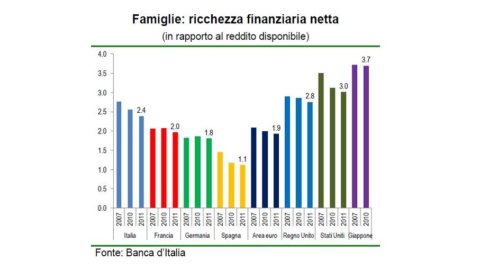The financial assets and liabilities of households in the euro area have crystallized around the values of four years ago. The robust growth rates recorded on both sides of the household balance sheet in the middle of the last decade gradually lost intensity and in 2011 growth was 1,5% for assets and 2,1% for liabilities . In absolute values, the financial wealth of households in the Eurozone has fluctuated between 17 and 18 trillion euros in the last four years, while liabilities have stopped at around 6 trillion.
Last year, households' net financial wealth in the euro area was 1,9 times disposable income, a ratio that has been steadily decreasing since 2007. The EMU data replicates the experience of the main economies of the area considering that households in Italy, France, Germany and Spain have all recorded a decline in their assets compared to disposable income, albeit with different intensity. Nonetheless, our country continues to have a high level of financial wealth equal to approximately 2,4 times disposable income, the highest level among the main EMU partners.
La wealth of Italian families in 2011 decreased by 3,1% on a trend basis, the fifth decline in the past four years. At the end of 2011, the level of financial assets of Italian households was equal to €3.549 billion, €298 billion less than the peak of the first quarter of 2007 (-7,8%) and approximately equal to the values of mid-2005 (€3.527 ). Purchases of financial assets in 2011 (€41 bn.) were mainly directed towards medium and long-term government securities (+€47 bn.) and bank bonds (+€13 bn.) for the former this is due to the high yield ensured above all by the second half of the year, while the latter were driven by the banks' offer policies. Inflows into more liquid forms of investment (bank and postal deposits) amounted to €6,5 billion, the result of a decrease in demand deposits, those repayable at notice and repurchase agreements, only partially offset by the increase in fixed-term deposits.
During the same period it continued the purchase of policies and other insurance products (+€4,7 bn.), albeit to a significantly lesser extent than in 2010 when investments nearly reached €28 bn. New purchases of shares decreased by more than ¼, going from 53 to 11 billion euro. Overall, the composition of the financial portfolio of Italian households changed in favor of more liquid instruments with guaranteed returns: deposits reached 31,5%, bonds rose to 20,4%, reinforcing a national trend which sees the weight of this product decidedly higher than that of the main European and non-European partners. The increase in the share of pension and insurance products was more moderate (from 18,4 to 19,1). The drop in share prices and the decreased flows directed towards this type of investment led to the reduction of the weight, which fell to 25,6% (from 29% in 2010).
The reduction in financial savings should be seen in the broader decrease in the household savings rate which fell to 12% at the end of last year, the lowest level ever recorded in our country and now also among the lowest levels among the partners of the eurozone. With reference to consumer households only, the savings rate was 8,6%, down for the eighth consecutive year; since 2006 the amounts set aside by consumer households have been decreasing (-7% y/y in 2011) and last year for the first time in the last decade the amount fell below 100 billion euro.
On the other hand, the difficult economic situation continues to weigh on the savings capacity of Italian families, which in the last four years has led to an overall decrease in real income of 5%, while at the per capita level the contraction reached 7%. Many economic indicators denote the difficulties of families in undertaking new expenses: the latest consumer confidence climate survey highlights a prevalence of highly negative values on intentions to purchase durable goods and large expenditures, while new loan transactions to households reflect the expected reduction in the demand for loans by the same : the sums disbursed are in fact significantly distant from the values of past years for all types of financing.
Attachments: Focus no. 25 – 22 June 2012.pdf




